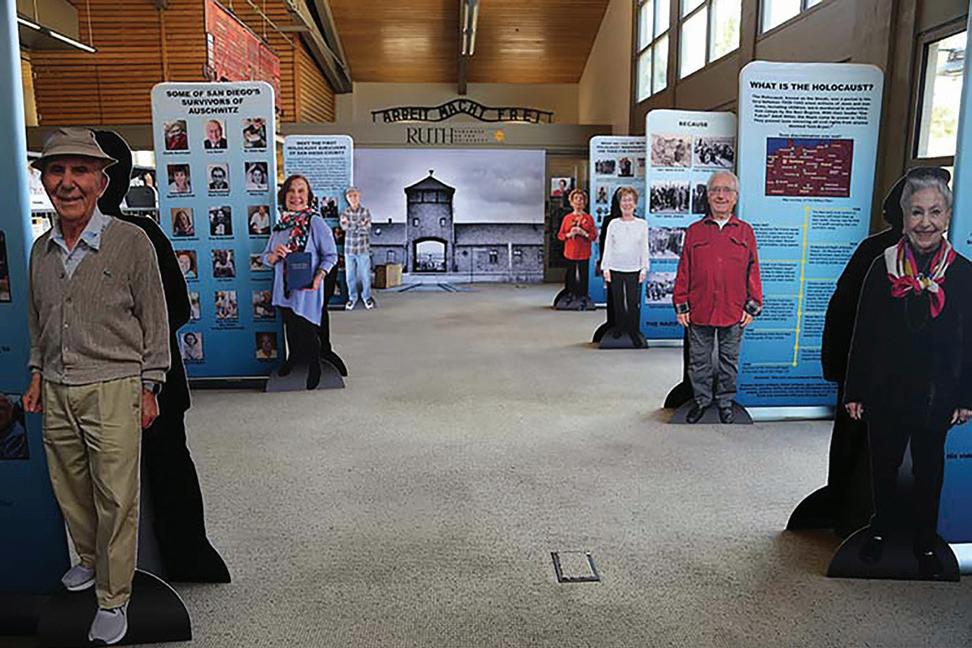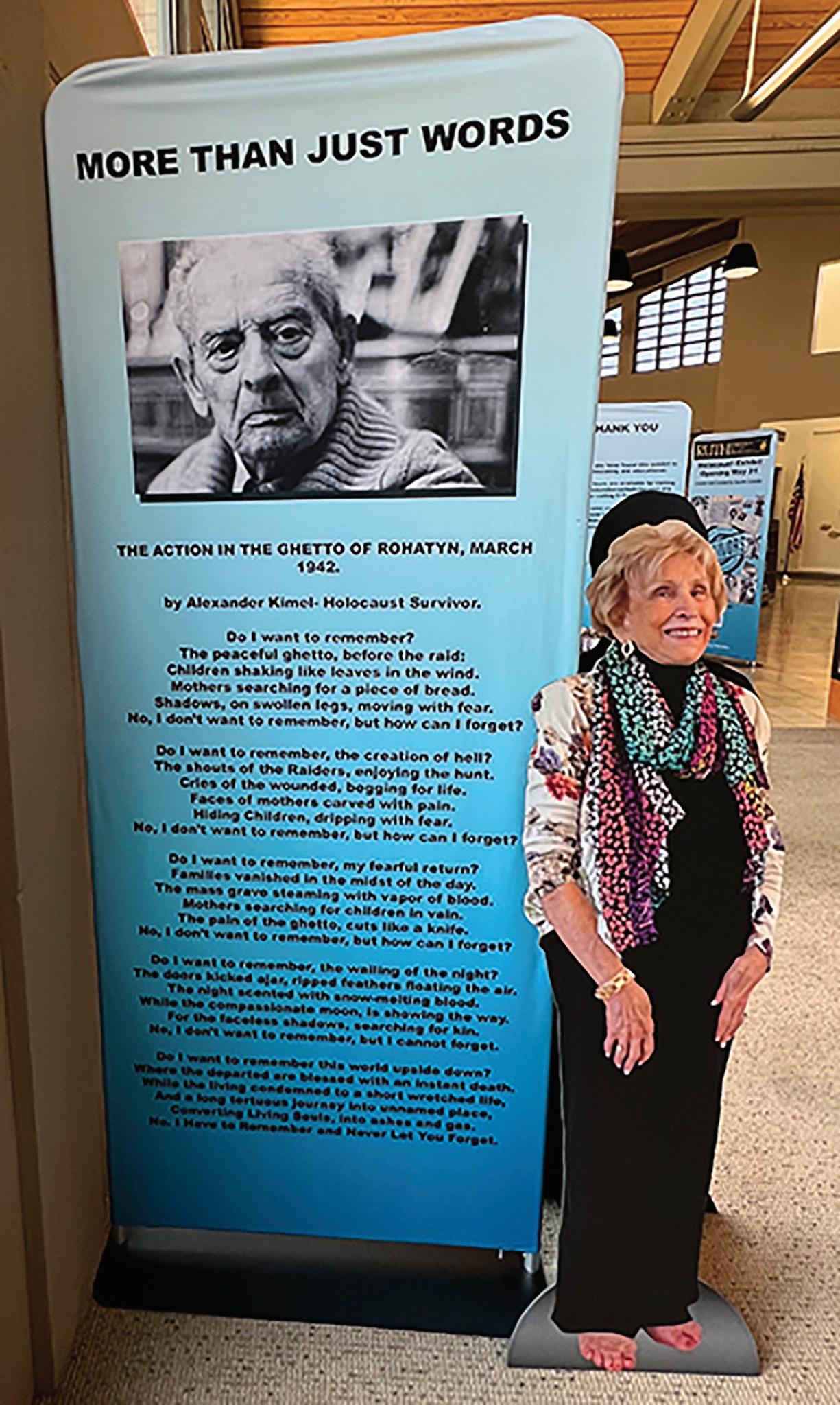
9 minute read
Holocaust Exhibition Features Survivors Who Settled in San Diego County
By Donald H. Harrison
tor, was 10 years old when German Nazis marched through the town of Brno, Czechoslovakia. She was forced to wear a yellow star and banned from public school. In 1941, she was deported to the ghetto of Theresienstadt. Three years later with her mother, she was transported to Auschwitz, where they were forced to stand naked six times in front of Dr. Josef Mengele, who determined whether camp inmates should live or die. They were sent to the Oederan labor camp, where Ruth worked in a bullet factory until Russian troops liberated the camp. When she and her mother returned to Brno, Ruth’s father, who had been taken away from them, miraculously was waiting for them.
Some like Goldshmiedova Sax have recently died; others like the Wallenfels couple are still among the ever-shrinking number of Holocaust survivors who are still alive and telling their stories.
the Nazis ran out of the striped pajamas normally issued to prisoners, they had them pick from a pile clothes previously worn by murdered inmates. The clothes were marked with a big X on the back. Each of those two pieces of clothing had stories attached to them. Fox was able to sew a place inside his uniform in which to secret a spoon. Goldshmiedova was able to hide a tiny Torah made from bread and spit into the hem of her dress. If that item had been spotted by the Nazi guards, she would have been executed.
There is much to read in addition to the shelved books at the Rancho San Diego County Library. From now until next May 21, 2024, which will be the one-year anniversary of a Holocaust exhibition curated by Sandra Scheller, visitors can read on standing panels a brief timeline of the Holocaust and the experiences of some victims who suffered through it and later settled in San Diego County.
Contemporary life-size figures of the survivors,
The exhibition relates that orphaned children, who in some cases saw their parents murdered by Nazi patrols, suffered great privations in hiding. They slept wherever they thought they might not be found. They were covered with lice, starving, and often suffered from typhus. “They went to sleep only to wake up next to those who died,” an exhibition panel related. “They covered their ears as they heard bombs. Some lost their teeth, some were all alone, families gone forever. They had nothing because they were Jewish.” Whose stories were these? The aforementioned Beim, Falus, Pakowitz, the Wallenfels as well as Lou Pechi and Harry Rosen.
The Six Million Jews who perished in the Holocaust were not the only victims that the Nazi haters put to death or imprisoned at hard labor for no reason other than being who they were. Blacks; Roma/ Gypsies; Gays; Political Enemies; Jehovah’s Witnesses; Disabled People, whether adults or children, were also on Hitler’s hit list.
World War II ended in 1945 with Germany surrendering and Hitler committing suicide. Survivors were liberated from the camps, but with no places to go, they languished for several years in Displaced Persons Camps. Immigration to the United States, and more particularly to San Diego, was underway by 1949. Four years later, the New Life Club was formed, in which survivors shared their dreams, provided support groups for one another, and eventually wrote books and gave speeches about their Holocaust experiences.

Among San Diego County Holocaust survivors who became authors were Werner Dreifuss, from Germany, who wrote The Epitome of the American Dream; psychologist Edith Eva Eger, from Hungary, who wrote The Choice and The Gift; Francheska Gelbart, who authored Frozen in Time; Fanny Krasner Lebovits, today over 100, who wrote Memories, Miracles & Meaning: Insights of a Holocaust Survivor; Ben Midler, who authored The Life of a Child Survivor from Bialystok, Poland; and Lou Pechi, from Croatia, who wrote I Am Lubo; A Hidden Life with Louis Pechi.
Beyond a door is another room in which photos from concentration camps are shown, including people in barracks, people moments before they were killed by poisonous gas, and the interior of a gas chamber. There is a video playing of a survivor giving testimony about Holocaust experiences. And there are pictures of a fake shower head that spewed poisonous gas, a Nazi arm band, and of the poison gas canisters. A printed warning before one enters the room is that some of the images may be unsuitable for young children.
The exhibition poses questions and lessons for viewers. It asks if they were in the Holocaust what would they have done? And do they think they could have survived?
Some of the lessons were: 1) Never stop talking about the Holocaust. Your best information comes from a survivor. Ask questions and never stop asking them. 2) All people have a responsibility to prevent such an atrocity from happening again. We cannot turn our backs and we must use our voices. The Holocaust did not begin in a camp or gas chambers; it began with intolerance and hatred. It continued with propaganda and lies. We must seek the truth. 3) Remaining silent is the greatest sin.... 4) Holocaust education is the key. We must encourage the study of the Holocaust in all its dimensions
A small panel expresses the hope that this yearlong exhibition will lead to the creation of a permanent Holocaust museum in San Diego County. There are two free takeaways from the library located at 11555 Via Rancho San Diego in El Cajon. Both are expensively printed El Sol magazines from Southwestern College, which awarded Scheller an honorary degree at its most recent graduation ceremony in honor of her curating the predecessor exhibition shown at the Chula Vista Public Library titled “RUTH: Remember Us The Holocaust.” An is- who later made their homes in this county, stand next to the panels, giving the exhibition a sense of immediacy. The exhibition capsulizes some of the experiences of survivors who had lived throughout Europe before the Holocaust. Adele Bein, from Holland, remembered watching her mother being kicked in the stomach by two Nazis. Vera Falus, from Hungary, recalled having her head shaved so that she could pose as a boy while in hiding. Anita Fuchs, from Romania, said her mother told her if anyone knocked at their door to hide under the bed. Ilona Medwied, from Poland, remembered being smuggled out of the Treblinka concentration camp and being hidden until the end of the war. Edith Palkowitz, from Hungary, will never forget Nazis kicking her down a flight of stairs, breaking her teeth. Manya and Mike Wallenfels escaped the Nazis in Hungary by hiding in forests, cemeteries and a swamp.
Ruth Goldschmiedova Sax, mother of the cura-
The late Gussie Zaks, from Poland, was described in the exhibition as “San Diego’s first lady of Holocaust survivors. As a Holocaust speaker and the President of the New Life Club... nothing stopped ‘Gutsy’ from facing antisemitism and teaching other Holocaust survivors to bond and not to be afraid to speak up.” In 1941 Nazis took her parents away from their home. At age 13, Gussie “was transported to several concentration camps, including Treblinka and Bergen-Belsen. Under brutal conditions she worked outdoors in the field with 1,000 other girls.” From later history, Gussie knew that the famed diarist, Anne Frank, was also at Bergen-Belsen in that time period, but they never met. “Everyone was too busy trying to survive to know who the others were.” After liberation, Gussie went to Sweden where she was nursed back to health. Years later, with husband Mike Zaks, she settled in San Diego. Some artifacts used by Holocaust lecturers are referenced in the exhibit. There is a photograph of the uniform that David Fox was issued at a concentration camp. His daughter Sonia Fox Ohlbaum takes it with her when she speaks to groups about the Holocaust. A dress worn by curator Scheller’s mother, with a big X on its back, is also exhibited. When sue in Spring of 2020 had Ruth Goldshmiedova Sax on its cover with the caption “Chula Vista’s beloved Holocaust survivor stared down Nazis to spread a message of peace.” In 2022, the cover of another issue pictured Rose Schindler, Benjamin Midler and Gerhard Maschowski showing the tattoos that were forced onto their arms. That article was headlined “Warriors for Peace.”

Curator Scheller offers tours of the exhibit every Thursday from 10:30 a.m. to 2 p.m.
VIDEO FROM LOCAL NEWS - SCAN HERE public’s challenges over the past three years have heavily contributed to heightened levels of overall ill health. “People are more depressed, more anxious.” A new approach to mental health, especially, is needed.



Sean Leonard is a Nurse Practitioner specializing in psychiatric care, based in Serene Health’s Oceanside office.
“I’m a board-certified primary care geriatric nurse practitioner and board-certified psychiatric nurse practitioner,” says Sean. His background in both addiction medicine and psychiatric stabilization, along with TMS, is just one reason Oscar counts him as a vital part of the organization.
“I have been a friend of Oscar’s for over five years in several other healthcare adventures,” says Sean. Coming now to Serene Health through a partnership, furthers my hopes of delivering PrTMS® to the masses. Working with Serene is the piece that had been missing in my profession.”
Putting It All Into Perspective
Every client is seen and evaluated by a psychiatrist, even if their primary issue is physical, and treated according to the psychiatrist’s recommendations. An initial EEG (electroencephalography) is taken, which records spontaneous electrical activity of the brain, for analysis.
A psychological evaluation is done and putting it all together, a personalized plan of action is established, using any of several treatment methods provided by Serene Health. EEGs are taken every week of treatment, so the protocols can change accordingly.
Coming full circle here, the comments from patients of Serene Health’s therapy are emphatic about its beneficial effects on their lives.
Chris Peters knows first-hand the benefits of PrTMS® treatment, not just in seeing the changes in his clients, but experiencing them himself.
After thirteen years as a firefighter, Chris didn’t think the job had impacted him that much, but he woke up one day and everything had just accumulated, piled on his shoulders, and “I just didn’t feel right, didn’t feel like myself,” Chris recalls. “I was in a fog every day. I couldn’t think clearly, couldn’t get thoughts out, and it began to interrupt my home life. I just wanted to sleep.”
He decided to seek help and was fortunate to see a doctor who knew Dr. Murphy and his TMS program. Chris took treatment and by the end of two months, he’d seen amazing results. More importantly, said Chris, his family “… saw dramatic improvement almost immediately. It’s just my belief, but I personally feel every firefighter could benefit from this.”
A police officer from San Diego, came to the MindSet by Serene Health Group with sleep-related issues, including moodiness and irritability. “From the very first session in the van, I felt a sense of peace, as though taking these steps would not only identify some of my issues, but could relieve them. It filled me with a sense of excitement.”
On a lasting basis, he found, “The treatment afforded me the ability to recognize when I was about to enter a high state of stress.” It provided him a type of buffer, and a marker, “… so I could more readily shift out of the ‘red zone’ into a more comfortable tempo. Especially at work.”
By being less reactionary, the officer explained, “I am able to take a tick and process the scene; feel like I have better clarity while making decisions under stress.” And at home, “My wife saw a difference in me and commented on how I was more at peace and easier to be around.”
The need for brain-to-body treatment should be fundamental, beginning with children in sports. Anthony Miller, former wide receiver for the San Diego Chargers, confirms recent news reports that football players (for instance) often pay heavily later in life, for their combative career choice.
Looking back, Anthony mentioned, “… I had three recorded concussions, and they said, ‘when you see stars, those are minor’; and I said, ‘man, I didn’t have just minor concussions—and I had those even in high school’.”
Today, however, he didn’t think he was having more problems than the average aging process seems to include. He also comes from a family of strong cognitive capacities and longevity, with his mother at eighty still going strong, following in the footsteps of her mother who lived to be ninety-eight. But, “… me at fiftyeight,” he admits, struggles with memory loss and absentmindedness.
“At first, I thought it was just me, then I started talking to some of my friends that played football and we realized we were experiencing some of the same conditions, like forgetting someone’s name and it comes to you five minutes later,” and he added with a laugh, “or a couple times I left the oven on and my girl [pointedly] reminded me. I’m not as sharp as I used to be … so I would do block puzzles and other things to stimulate my brain.”
Friend and Chargers’ hall-of-famer, Wes Chandler, put Anthony in touch with Serene Health. “It’s been very helpful to our guys who have played the game, with [resulting] concussion issues, and their overall health.” He attended a meeting in which Serene staff offered treatment which he thought could be beneficial. Anthony appreciated their convenient mobile unit too, which delivered an intensive month











